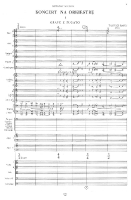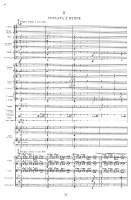Concerto for Orchestra (1953)
The Concerto for Orchestra is dedicated to Kazimierz Serocki. It is scored for large symphony orchestra. In the four-movement structure of the work we will no longer find the sonata form.
I. Grave e fugato
The formal outline of this movement (which serves as an introduction in the entire cycle) is emphasised by three major chords appearing in this non-tonal work. The arch-like ABA form is thus highlighted by the chords of A flat major, C major and D major.
II.Scherzo
This fragment, like a perpetuum mobile, maintains its motoric nature guaranteed by constant quaver movement. The whole is constructed as one part and is based on two seemingly contrasting phases. We will find here references to Baird’s earlier pieces: Sinfonietta (1st movement), Symphony No. 1 (5th movement), Two Caprices for clarinet and piano (1st movement).
III.Recitativo e arioso
This part is greatly charged emotionally and is characterised by a subtlety of sound and reticence in using the orchestra. It is a monolith evolving gradually, with a polyphonic texture, and uses motifs known from the first movement. Despite a lack of any tonal declarations, it is crowned with a bright and delicate E major chord. The third movement is the most individual fragment in the entire work.
IV. Toccata ed inno
The finale is based on a theme we can find in Baird’s earlier compositions (in the song Cold dew and the first movement of Two Caprices). The work’s fast tempo, regular rhythmic pulsation and performance virtuosity of the entire orchestra fit in with the Baroque toccata “model”, while elements of compositional improvisation are visible in the variation-based setting of the theme. An hymn (Inno) closes not only the last section in the Concerto, but, first of all, the entire cycle.
In its sound and expression, the Concerto for Orchestra is thoroughly monumental and dramatic. It is Baird’s last symphonic work of neo-classical character, with references to Baroque and medieval music. Reviews of the Łódź premiere in May 1954 stressed the significance of the composition. According to Stefan Jarociński:
In none of his previous works did Baird speak so fully and maturely, in none did he develop such a richness of means of expression and such a mastery of the compositional technique. The Concerto for orchestra is among his greatest creative achievements [...].
The Concerto for Orchestra won Baird the Award of the Minister of Culture and Art at the 2nd Polish Music Festival (1955) and the 3rd Prize at the International Composers’ Competition (in the symphonic-vocal category) organised to mark the 5th World Festival of Youth and Students for Peace and Friendship in Warsaw (1955).







